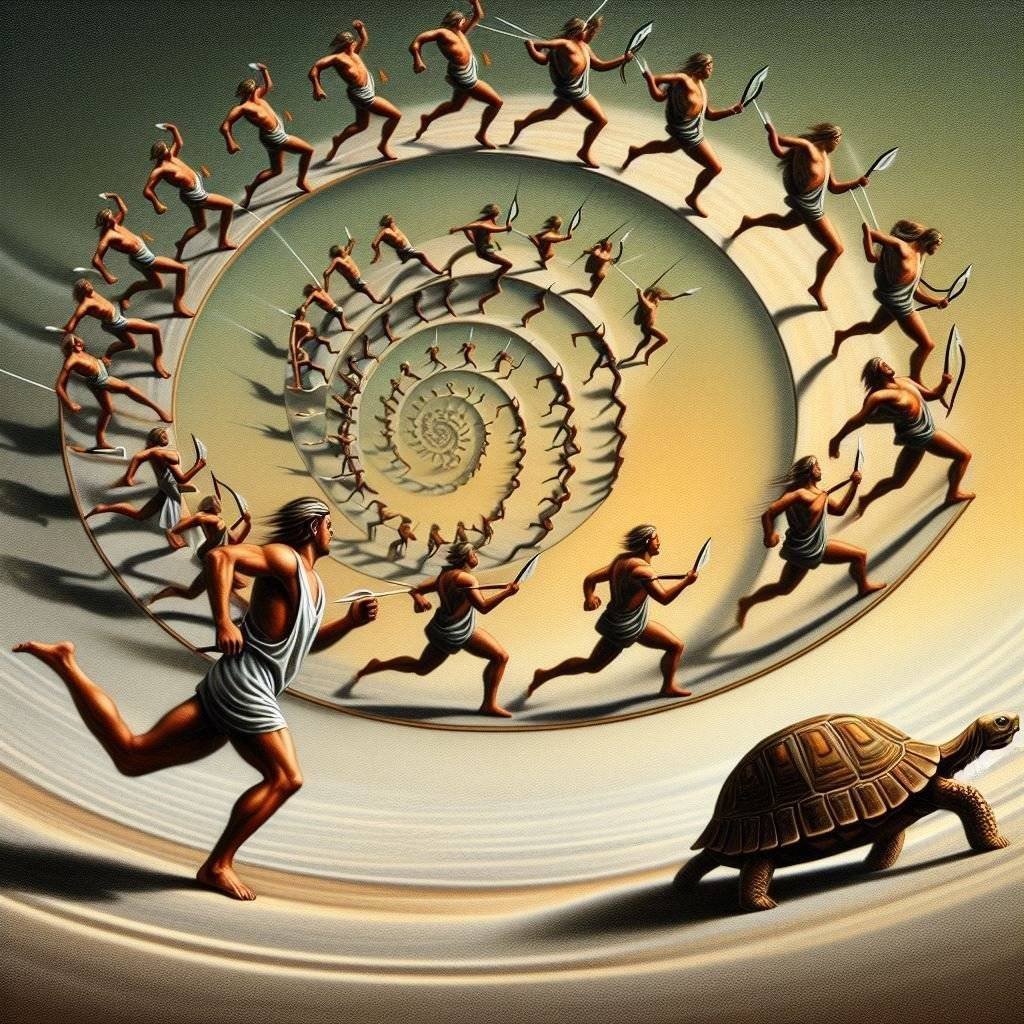Zeno of Elea, a 5th-century BC Greek philosopher, is renowned for his paradoxes, thought experiments that challenged prevailing ideas about motion, infinity, and divisibility. These paradoxes, particularly the Dichotomy Paradox, have captivated mathematicians and philosophers for centuries, forcing us to re-examine our intuitive understanding of movement and the nature of space and time.
The Dichotomy Paradox: A Race Before You Start
Imagine a race between Achilles, the swift-footed hero, and a slow-moving tortoise. To give the tortoise a head start, Achilles lets it begin halfway down the racetrack. Here’s the paradox:
- Premise 1: Achilles must first reach the point where the tortoise is.
- Premise 2: By the time Achilles gets there, the tortoise will have moved some distance further ahead.
- Premise 3: Achilles must then cover this new distance between them.
- Contradiction: This process of Achilles needing to cover progressively smaller distances to reach the tortoise seems to imply he will never actually reach it. He has to complete an infinite number of steps, each taking a finite amount of time – an infinite series of finite durations seems to lead to an infinite total duration.
The Challenge to Motion:
The Dichotomy Paradox seemingly negates the possibility of motion. If reaching any destination requires an infinite series of steps, then how can any movement ever truly occur? This paradox exposed a fundamental flaw in the prevailing atomistic view of the time, which held that both space and time were infinitely divisible.
Achilles and the Arrow: Another Paradox of Motion
Zeno’s paradoxes extend beyond reaching a destination. Consider the Arrow Paradox:
- Premise: An arrow in flight occupies a specific position at any given instant.
- Contradiction: Since time is made up of indivisible instants, the arrow cannot be moving during any of these single moments. If it’s not moving at any single instant, how can it be moving at all?
The Paradox of Infinity:
Both the Dichotomy and Arrow Paradoxes hinge on the concept of infinity. Dividing both space and time into infinitely small parts leads to seemingly insurmountable challenges. Can something be infinitely divisible? Does an infinite series of finite quantities necessarily lead to an infinite total? These were the questions Zeno’s paradoxes forced us to confront.
Beyond Zeno’s Time: Solutions and Interpretations:
While Zeno’s paradoxes may seem like philosophical puzzles, mathematicians and philosophers have offered various solutions and interpretations:
- The Calculus Approach: The development of calculus by Newton and Leibniz provided a framework for dealing with infinitesimals, infinitely small quantities that can be summed to produce a finite value. This approach allowed us to mathematically define and analyze motion.
- The Paradoxes and Set Theory: Modern set theory distinguishes between different types of infinity. Some infinities are “larger” than others, and not all infinite sets can be paired one-to-one. This distinction aids in understanding the paradoxes.
- Zeno’s Assumptions Challenged: Some interpretations argue that Zeno’s paradoxes rely on flawed assumptions about the nature of space and time. Perhaps space and time are not infinitely divisible, as Zeno assumed.
The Legacy of Zeno’s Paradoxes:
Even without definitive solutions, Zeno’s paradoxes hold enduring value:
- Questioning Assumptions: They force us to re-examine our intuitive understanding of motion, infinity, and the nature of reality.
- The Importance of Rigorous Thinking: Zeno’s paradoxes highlight the need for precise definitions and logical reasoning in mathematics and philosophy.
- A Foundation for Mathematical Advancements: The paradoxes spurred the development of calculus and set theory, essential tools in modern mathematics.
Beyond Motion: Applications in the Modern World
The ideas behind Zeno’s paradoxes find relevance in unexpected places:
- Computer Graphics: Rendering smooth motion in animation relies on the concept of infinitesimals and how infinitely small changes create the illusion of continuous movement.
- Physics: The paradoxes raise questions about the nature of space and time, which remain subjects of ongoing exploration in physics, particularly in the realm of quantum mechanics and relativity.
Zeno’s Enduring Enigma: A Journey Without a Destination
Zeno’s paradoxes may not offer definitive answers about motion or infinity. Instead, they serve as a springboard for exploration. They remind us that our understanding of the universe is constantly evolving, and that seemingly simple concepts like motion hold complexities waiting to be unraveled. The journey through Zeno’s paradoxes may not have a final destination, but it continues to be a voyage of intellectual discovery, challenging our assumptions and pushing the boundaries of our knowledge.



